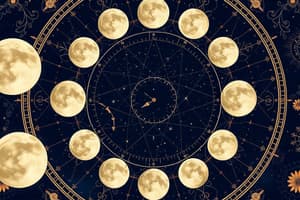Podcast
Questions and Answers
True or false: We always see the same side of the Moon.
True or false: We always see the same side of the Moon.
True (A)
True or false: The near side of the Moon has both light and dark regions.
True or false: The near side of the Moon has both light and dark regions.
True (A)
True or false: Tidal forces are responsible for why we only see one side of the Moon.
True or false: Tidal forces are responsible for why we only see one side of the Moon.
True (A)
True or false: The rotation period of the Moon is exactly equal to its orbital period.
True or false: The rotation period of the Moon is exactly equal to its orbital period.
True or false: The far side of the Moon is forever hidden from our view.
True or false: The far side of the Moon is forever hidden from our view.
True or false: To view the far side of the Moon, we would need to go there or send a spacecraft.
True or false: To view the far side of the Moon, we would need to go there or send a spacecraft.
True or false: The phases of the Moon occur due to the Moon's position in its orbit with respect to the incoming sunlight.
True or false: The phases of the Moon occur due to the Moon's position in its orbit with respect to the incoming sunlight.
True or false: The moon is always moving in an eastward direction?
True or false: The moon is always moving in an eastward direction?
True or false: The moon gets closer to the Sun as it moves in the sky?
True or false: The moon gets closer to the Sun as it moves in the sky?
True or false: The new moon rises with the Sun and sets at sunset?
True or false: The new moon rises with the Sun and sets at sunset?
True or false: The moon transits the meridian at the same time as the Sun?
True or false: The moon transits the meridian at the same time as the Sun?
True or false: The near side of the Moon is always illuminated?
True or false: The near side of the Moon is always illuminated?
True or false: The moon is dark at some point or another?
True or false: The moon is dark at some point or another?
True or false: The moon has a dark side that is always dark?
True or false: The moon has a dark side that is always dark?
True or false: The moon goes through a full lunar cycle every month?
True or false: The moon goes through a full lunar cycle every month?
True or false: The moon is approximately the same age as Earth?
True or false: The moon is approximately the same age as Earth?
The moon is currently in the new phase.
The moon is currently in the new phase.
The waxing crescent moon rises later and later as it gets closer to the first quarter phase.
The waxing crescent moon rises later and later as it gets closer to the first quarter phase.
The first quarter moon sets around midnight.
The first quarter moon sets around midnight.
The waxing gibbous moon rises in the afternoon.
The waxing gibbous moon rises in the afternoon.
The full moon rises just at sunset.
The full moon rises just at sunset.
The waning gibbous moon rises very late at night.
The waning gibbous moon rises very late at night.
The third quarter moon sets at noon.
The third quarter moon sets at noon.
The waxing crescent phase of the moon occurs when the moon is about one-fourth of the way around in its revolution around the earth.
The waxing crescent phase of the moon occurs when the moon is about one-fourth of the way around in its revolution around the earth.
The first quarter phase of the moon is also known as the half moon.
The first quarter phase of the moon is also known as the half moon.
The waning gibbous phase of the moon occurs when the moon is coming around to basically opposite the Earth from the Sun.
The waning gibbous phase of the moon occurs when the moon is coming around to basically opposite the Earth from the Sun.
The third quarter phase of the moon occurs when the moon has gone three-quarters of the way around in its orbit.
The third quarter phase of the moon occurs when the moon has gone three-quarters of the way around in its orbit.
The moon disappears during the third quarter phase.
The moon disappears during the third quarter phase.
The synodic month, or solar month, is the time it takes for the moon to make one full revolution around the Earth.
The synodic month, or solar month, is the time it takes for the moon to make one full revolution around the Earth.
From any given phase to any given phase, it takes twenty-nine and a half days to get there.
From any given phase to any given phase, it takes twenty-nine and a half days to get there.
Flashcards are hidden until you start studying




